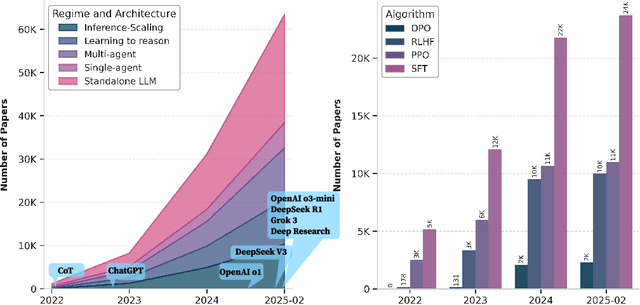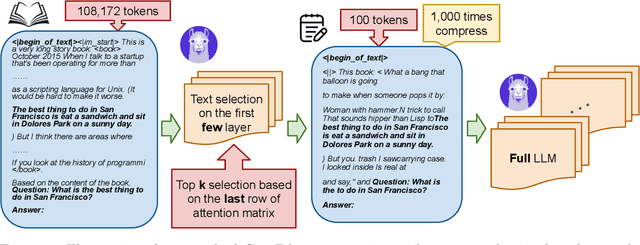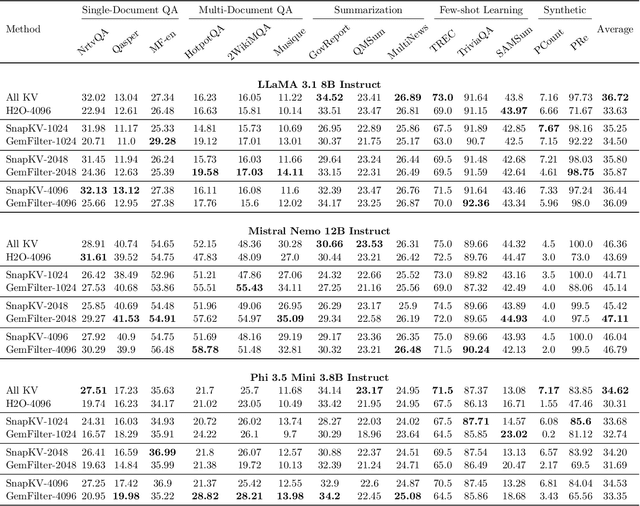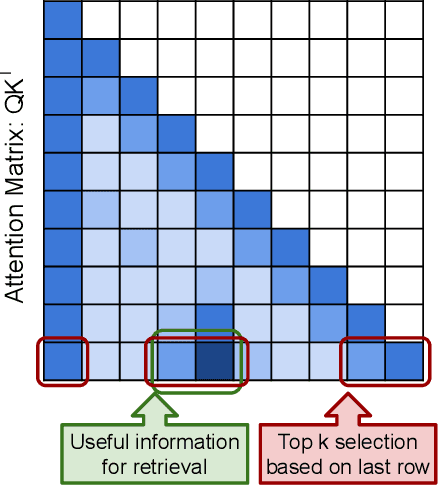Yifei Ming
LiveResearchBench: A Live Benchmark for User-Centric Deep Research in the Wild
Oct 16, 2025Abstract:Deep research -- producing comprehensive, citation-grounded reports by searching and synthesizing information from hundreds of live web sources -- marks an important frontier for agentic systems. To rigorously evaluate this ability, four principles are essential: tasks should be (1) user-centric, reflecting realistic information needs, (2) dynamic, requiring up-to-date information beyond parametric knowledge, (3) unambiguous, ensuring consistent interpretation across users, and (4) multi-faceted and search-intensive, requiring search over numerous web sources and in-depth analysis. Existing benchmarks fall short of these principles, often focusing on narrow domains or posing ambiguous questions that hinder fair comparison. Guided by these principles, we introduce LiveResearchBench, a benchmark of 100 expert-curated tasks spanning daily life, enterprise, and academia, each requiring extensive, dynamic, real-time web search and synthesis. Built with over 1,500 hours of human labor, LiveResearchBench provides a rigorous basis for systematic evaluation. To evaluate citation-grounded long-form reports, we introduce DeepEval, a comprehensive suite covering both content- and report-level quality, including coverage, presentation, citation accuracy and association, consistency and depth of analysis. DeepEval integrates four complementary evaluation protocols, each designed to ensure stable assessment and high agreement with human judgments. Using LiveResearchBench and DeepEval, we conduct a comprehensive evaluation of 17 frontier deep research systems, including single-agent web search, single-agent deep research, and multi-agent systems. Our analysis reveals current strengths, recurring failure modes, and key system components needed to advance reliable, insightful deep research.
Beyond Accuracy: Dissecting Mathematical Reasoning for LLMs Under Reinforcement Learning
Jun 05, 2025Abstract:Reinforcement learning (RL) has become the dominant paradigm for endowing language models with advanced reasoning capabilities. Despite the substantial empirical gains demonstrated by RL-based training methods like GRPO, a granular understanding of their advantages is still lacking. To address this gap, we introduce a fine-grained analytic framework to dissect the impact of RL on reasoning. Our framework specifically investigates key elements that have been hypothesized to benefit from RL training: (1) plan-following and execution, (2) problem decomposition, and (3) improved reasoning and knowledge utilization. Using this framework, we gain insights beyond mere accuracy. For instance, providing models with explicit step-by-step plans surprisingly degrades performance on the most challenging benchmarks, yet RL-tuned models exhibit greater robustness, experiencing markedly smaller performance drops than their base counterparts. This suggests that RL may not primarily enhance the execution of external plans but rather empower models to formulate and follow internal strategies better suited to their reasoning processes. Conversely, we observe that RL enhances the model's capacity to integrate provided knowledge into its reasoning process, leading to performance improvements across diverse tasks. We also study difficulty, showing improved training by developing new ways to exploit hard problems. Our findings lay a foundation for more principled training and evaluation of reasoning models.
MAS-ZERO: Designing Multi-Agent Systems with Zero Supervision
May 26, 2025Abstract:Multi-agent systems (MAS) leveraging the impressive capabilities of Large Language Models (LLMs) hold significant potential for tackling complex tasks. However, most current MAS depend on manually designed agent roles and communication protocols. These manual designs often fail to align with the underlying LLMs' strengths and struggle to adapt to novel tasks. Recent automatic MAS approaches attempt to mitigate these limitations but typically necessitate a validation set for tuning and yield static MAS designs lacking adaptability during inference. We introduce MAS-ZERO, the first self-evolved, inference-time framework for automatic MAS design. MAS-ZERO employs meta-level design to iteratively generate, evaluate, and refine MAS configurations tailored to each problem instance, without requiring a validation set. Critically, it enables dynamic agent composition and problem decomposition through meta-feedback on solvability and completeness. Experiments across math, graduate-level QA, and software engineering benchmarks, using both closed-source and open-source LLM backbones of varying sizes, demonstrate that MAS-ZERO outperforms both manual and automatic MAS baselines, achieving a 7.44% average accuracy improvement over the next strongest baseline while maintaining cost-efficiency. These findings underscore the promise of meta-level self-evolved design for creating effective and adaptive MAS.
Meta-Design Matters: A Self-Design Multi-Agent System
May 21, 2025Abstract:Multi-agent systems (MAS) leveraging the impressive capabilities of Large Language Models (LLMs) hold significant potential for tackling complex tasks. However, most current MAS depend on manually designed agent roles and communication protocols. These manual designs often fail to align with the underlying LLMs' strengths and struggle to adapt to novel tasks. Recent automatic MAS approaches attempt to mitigate these limitations but typically necessitate a validation-set for tuning and yield static MAS designs lacking adaptability during inference. We introduce SELF-MAS, the first self-supervised, inference-time only framework for automatic MAS design. SELF-MAS employs meta-level design to iteratively generate, evaluate, and refine MAS configurations tailored to each problem instance, without requiring a validation set. Critically, it enables dynamic agent composition and problem decomposition through meta-feedback on solvability and completeness. Experiments across math, graduate-level QA, and software engineering benchmarks, using both closed-source and open-source LLM back-bones of varying sizes, demonstrate that SELF-MAS outperforms both manual and automatic MAS baselines, achieving a 7.44% average accuracy improvement over the next strongest baseline while maintaining cost-efficiency. These findings underscore the promise of meta-level self-supervised design for creating effective and adaptive MAS.
A Survey of Frontiers in LLM Reasoning: Inference Scaling, Learning to Reason, and Agentic Systems
Apr 12, 2025



Abstract:Reasoning is a fundamental cognitive process that enables logical inference, problem-solving, and decision-making. With the rapid advancement of large language models (LLMs), reasoning has emerged as a key capability that distinguishes advanced AI systems from conventional models that empower chatbots. In this survey, we categorize existing methods along two orthogonal dimensions: (1) Regimes, which define the stage at which reasoning is achieved (either at inference time or through dedicated training); and (2) Architectures, which determine the components involved in the reasoning process, distinguishing between standalone LLMs and agentic compound systems that incorporate external tools, and multi-agent collaborations. Within each dimension, we analyze two key perspectives: (1) Input level, which focuses on techniques that construct high-quality prompts that the LLM condition on; and (2) Output level, which methods that refine multiple sampled candidates to enhance reasoning quality. This categorization provides a systematic understanding of the evolving landscape of LLM reasoning, highlighting emerging trends such as the shift from inference-scaling to learning-to-reason (e.g., DeepSeek-R1), and the transition to agentic workflows (e.g., OpenAI Deep Research, Manus Agent). Additionally, we cover a broad spectrum of learning algorithms, from supervised fine-tuning to reinforcement learning such as PPO and GRPO, and the training of reasoners and verifiers. We also examine key designs of agentic workflows, from established patterns like generator-evaluator and LLM debate to recent innovations. ...
Adaptation of Large Language Models
Apr 04, 2025Abstract:This tutorial on adaptation of LLMs is designed to address the growing demand for models that go beyond the static capabilities of generic LLMs by providing an overview of dynamic, domain-specific, and task-adaptive LLM adaptation techniques. While general LLMs have demonstrated strong generalization across a variety of tasks, they often struggle to perform well in specialized domains such as finance, healthcare, and code generation for underrepresented languages. Additionally, their static nature limits their ability to evolve with the changing world, and they are often extremely large in size, making them impractical and costly to deploy at scale. As a result, the adaptation of LLMs has drawn much attention since the birth of LLMs and is of core importance, both for industry, which focuses on serving its targeted users, and academia, which can greatly benefit from small but powerful LLMs. To address this gap, this tutorial aims to provide an overview of the LLM adaptation techniques. We start with an introduction to LLM adaptation, from both the data perspective and the model perspective. We then emphasize how the evaluation metrics and benchmarks are different from other techniques. After establishing the problems, we explore various adaptation techniques. We categorize adaptation techniques into two main families. The first is parametric knowledge adaptation, which focuses on updating the parametric knowledge within LLMs. Additionally, we will discuss real-time adaptation techniques, including model editing, which allows LLMs to be updated dynamically in production environments. The second kind of adaptation is semi-parametric knowledge adaptation, where the goal is to update LLM parameters to better leverage external knowledge or tools through techniques like retrieval-augmented generation (RAG) and agent-based systems.
Does Context Matter? ContextualJudgeBench for Evaluating LLM-based Judges in Contextual Settings
Mar 19, 2025Abstract:The large language model (LLM)-as-judge paradigm has been used to meet the demand for a cheap, reliable, and fast evaluation of model outputs during AI system development and post-deployment monitoring. While judge models -- LLMs finetuned to specialize in assessing and critiquing model outputs -- have been touted as general purpose evaluators, they are typically evaluated only on non-contextual scenarios, such as instruction following. The omission of contextual settings -- those where external information is used as context to generate an output -- is surprising given the increasing prevalence of retrieval-augmented generation (RAG) and summarization use cases. Contextual assessment is uniquely challenging, as evaluation often depends on practitioner priorities, leading to conditional evaluation criteria (e.g., comparing responses based on factuality and then considering completeness if they are equally factual). To address the gap, we propose ContextualJudgeBench, a judge benchmark with 2,000 challenging response pairs across eight splits inspired by real-world contextual evaluation scenarios. We build our benchmark with a multi-pronged data construction pipeline that leverages both existing human annotations and model-based perturbations. Our comprehensive study across 11 judge models and 9 general purpose models, reveals that the contextual information and its assessment criteria present a significant challenge to even state-of-the-art models. For example, OpenAI's o1, the best-performing model, barely reaches 55% consistent accuracy.
Demystifying Domain-adaptive Post-training for Financial LLMs
Jan 09, 2025



Abstract:Domain-adaptive post-training of large language models (LLMs) has emerged as a promising approach for specialized domains such as medicine and finance. However, significant challenges remain in identifying optimal adaptation criteria and training strategies across varying data and model configurations. To address these challenges, we introduce FINDAP, a systematic and fine-grained investigation into domain-adaptive post-training of LLMs for the finance domain. Our approach begins by identifying the core capabilities required for the target domain and designing a comprehensive evaluation suite aligned with these needs. We then analyze the effectiveness of key post-training stages, including continual pretraining, instruction tuning, and preference alignment. Building on these insights, we propose an effective training recipe centered on a novel preference data distillation method, which leverages process signals from a generative reward model. The resulting model, Llama-Fin, achieves state-of-the-art performance across a wide range of financial tasks. Our analysis also highlights how each post-training stage contributes to distinct capabilities, uncovering specific challenges and effective solutions, providing valuable insights for domain adaptation of LLMs. Project page: https://github.com/SalesforceAIResearch/FinDap
Discovering the Gems in Early Layers: Accelerating Long-Context LLMs with 1000x Input Token Reduction
Sep 25, 2024



Abstract:Large Language Models (LLMs) have demonstrated remarkable capabilities in handling long context inputs, but this comes at the cost of increased computational resources and latency. Our research introduces a novel approach for the long context bottleneck to accelerate LLM inference and reduce GPU memory consumption. Our research demonstrates that LLMs can identify relevant tokens in the early layers before generating answers to a query. Leveraging this insight, we propose an algorithm that uses early layers of an LLM as filters to select and compress input tokens, significantly reducing the context length for subsequent processing. Our method, GemFilter, demonstrates substantial improvements in both speed and memory efficiency compared to existing techniques, such as standard attention and SnapKV/H2O. Notably, it achieves a 2.4$\times$ speedup and 30\% reduction in GPU memory usage compared to SOTA methods. Evaluation on the Needle in a Haystack task shows that GemFilter significantly outperforms standard attention, SnapKV and demonstrates comparable performance on the LongBench challenge. GemFilter is simple, training-free, and broadly applicable across different LLMs. Crucially, it provides interpretability by allowing humans to inspect the selected input sequence. These findings not only offer practical benefits for LLM deployment, but also enhance our understanding of LLM internal mechanisms, paving the way for further optimizations in LLM design and inference. Our code is available at \url{https://github.com/SalesforceAIResearch/GemFilter}.
SFR-RAG: Towards Contextually Faithful LLMs
Sep 16, 2024Abstract:Retrieval Augmented Generation (RAG), a paradigm that integrates external contextual information with large language models (LLMs) to enhance factual accuracy and relevance, has emerged as a pivotal area in generative AI. The LLMs used in RAG applications are required to faithfully and completely comprehend the provided context and users' questions, avoid hallucination, handle unanswerable, counterfactual or otherwise low-quality and irrelevant contexts, perform complex multi-hop reasoning and produce reliable citations. In this paper, we introduce SFR-RAG, a small LLM that is instruction-tuned with an emphasis on context-grounded generation and hallucination minimization. We also present ContextualBench, a new evaluation framework compiling multiple popular and diverse RAG benchmarks, such as HotpotQA and TriviaQA, with consistent RAG settings to ensure reproducibility and consistency in model assessments. Experimental results demonstrate that our SFR-RAG-9B model outperforms leading baselines such as Command-R+ (104B) and GPT-4o, achieving state-of-the-art results in 3 out of 7 benchmarks in ContextualBench with significantly fewer parameters. The model is also shown to be resilient to alteration in the contextual information and behave appropriately when relevant context is removed. Additionally, the SFR-RAG model maintains competitive performance in general instruction-following tasks and function-calling capabilities.
 Add to Chrome
Add to Chrome Add to Firefox
Add to Firefox Add to Edge
Add to Edge